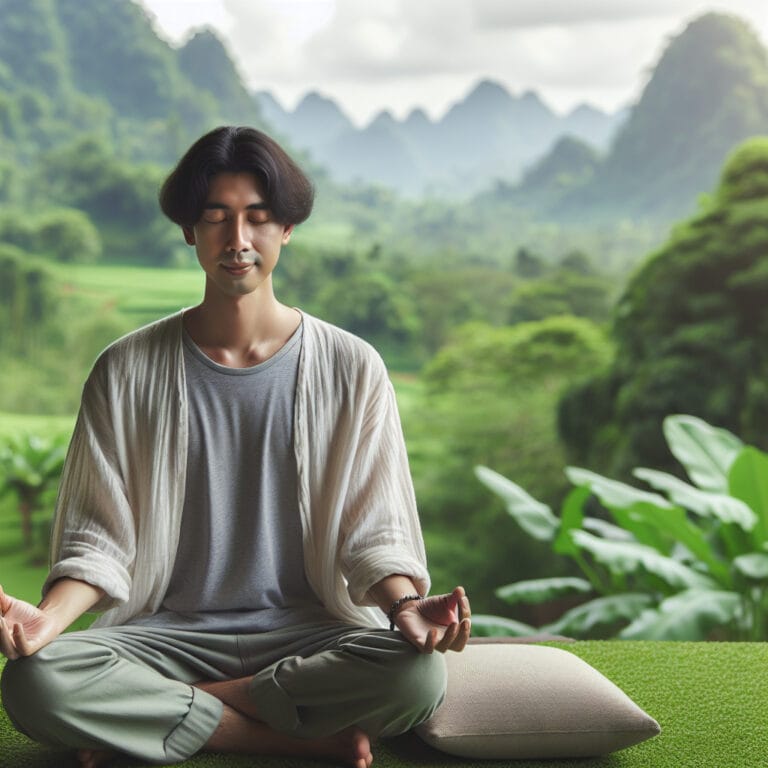
Mastering the Principles of Meditation: A Guide to Inner Peace
Table of Contents
- Introduction to Meditation
- Understanding the Different Types of Meditation
- Preparing for Meditation
- The Core Principles of Effective Meditation
- Techniques for Enhancing Meditation Practice
- Overcoming Common Meditation Challenges
- Integrating Meditation into Daily Life
- The Benefits of Regular Meditation Practice
- Conclusion
- Frequently Asked Questions
Introduction to Meditation
Meditation, an ancient practice deeply rooted in cultural histories around the world, has often been likened to a key, unlocking the door to inner peace and self-awareness. Pioneering insights from both modern science and traditional wisdom have shown that meditation practice can profoundly reshape our experience of thoughts and emotions, fostering a stable mind even amidst life’s turbulence. As we delve into varied forms of meditation—be it the focused calm abiding meditation or the reflective insight meditation—a common thread emerges: each technique is a pathway toward understanding our true nature.
Among these practices stands Insight Meditation, a Buddhist tradition where attention is honed on present moment experiences, cultivating an emotional response characterized by clarity and equanimity. Highly regarded for its transformative power, this form of meditative inquiry allows individuals to witness the empty nature of disturbing emotions without entrapment in their tumultuous narratives. Similarly enlightening are guided meditations led by seasoned practitioners such as Indian scholar Om Swami or tales of great Buddhist meditators like Tilopa; these narratives act as beacons guiding us through our own journeys.
Finding comfort in a comfortable position, seekers embarking on this introspective voyage learn to gently shift focus away from past memories and future anxieties towards recollection simply rooted in now—listening attentively not just to sound but also to silence. The integration of mindfulness into daily routines becomes less daunting when one views life itself as a mindful container; post-meditation experiences are imbued with lessons learned during periods of quiet introspection.
Beyond personal growth, contemporary society increasingly recognizes meditation’s multifaceted benefits—a salve for overstimulated minds seeking respite from an incessant cascade of information. Regularly attending meditation classes or establishing personal routines cultivates resilience against life’s inevitable stressors while nurturing compassion for oneself and others.
As explorers on this timeless quest for tranquility and wisdom continue their pursuit—whether alone or within communities—it becomes clear that each breath taken in stillness is another step toward harmonious living where every thought and emotion is acknowledged yet unfettered by their grip. This evolving understanding reiterates not only the depth but also the accessibility of contemplative practices designed for all earnest seekers regardless of background or belief.
Understanding the Different Types of Meditation
Meditation practice, a vital component of holistic well-being, encompasses a spectrum of methods each designed to foster a stable mind and emotional balance. Insight Meditation, specifically rooted in Buddhist teachings, encourages practitioners to gain clarity by observing thoughts and emotions without attachment—highlighting the empty nature of disturbing emotions. This practice promises a serene awareness of the present moment, enabling individuals to witness life’s unfolding with equanimity. Furthermore, great Buddhist meditators like Tilopa and Indian scholars such as Om Swami have emphasized the transformative power of engaging fully with the here and now through meditative disciplines.
Transitioning from Insight Meditation’s introspective depths leads us towards Calm Abiding Meditation—a method aimed at achieving mental tranquility by fixing one’s concentration on a single point. The practitioner settles into a comfortable position and gently shifts focus away from past memories or future anxieties to recollection simply centered in the present. This technique aids in cultivating concentration that supports all other meditation practices.
Guided Meditations serve as an invaluable tool for beginners embarking on their journey into mindfulness. Guided by experienced instructors or recordings, these sessions provide structured pathways through vivid imagery or specific tasks that aid participants in navigating their internal landscapes—cultivating both insight and relaxation.
Vipassana Meditation stands out for its meticulous approach towards developing deep self-awareness and insight into the true nature of reality. It involves systematically scanning the body’s sensations while maintaining detached observation—experiencing thoughts and physical feelings as transient events within a mindful container that is our consciousness.
Compassion is at the heart of Loving-kindness Meditation (Metta). In this practice where emotional response is key, individuals send out wishes for well-being—not just for themselves but extending outward to encompass others—a process fostering profound interconnection and empathy within communities.
Integrating mindfulness into daily life after meditation can be seamless when post-meditation experiences are viewed through lessons gleaned during stillness; thus transforming everyday actions into extensions of meditative practice. Regular attendance at meditation classes helps reinforce these skills leading to enhanced resilience against stressors faced in modern living environments.
Each variety of meditation decodes different aspects of human experience—the sound listen we give to our breath in quietude echoes through our lives influencing how we interact with ourselves and those around us. Whether individually exploring insights offered by wise figures like Om Swami or collectively sitting with peers engaged in recollecting simply being, every form brings forth unique benefits essential for nurturing a balanced existence amidst today’s relentless pace.
| Type of Meditation | Focus | Benefits | Notable Practitioners/Scholars |
|---|---|---|---|
| Insight Meditation | Observing thoughts and emotions without attachment | Serene awareness, equanimity, clarity | Tilopa, Om Swami |
| Calm Abiding Meditation | Concentration on a single point | Mental tranquility, supports other practices | — |
| Guided Meditations | Vivid imagery or specific tasks | Insight, relaxation, ideal for beginners | — |
| Vipassana Meditation | Scanning body’s sensations, detached observation | Deep self-awareness, insight into reality | — |
| Loving-kindness Meditation (Metta) | Sending out wishes for well-being | Compassion, interconnection, empathy | — |
| Mindfulness in Daily Life | Applying meditative lessons to actions | Enhanced resilience, transformation of everyday actions | — |
Preparing for Meditation
Embarking on a journey of meditation practice offers a sanctuary for the mind, where one can navigate the tumultuous sea of thoughts and emotions with the steadfast compass of mindfulness. Imagine adopting the tranquil posture of a Buddhist monk, your body in a comfortable position that transcends time and space, ready to explore the innermost corners of your psyche through insight meditation. Here, in this sacred present moment, you gently shift focus from past memories and future anxieties to a recollection simply centered on now—allowing meditating simply to become an act as natural as breathing.
For those seeking serenity within everyday chaos, calm abiding meditation serves as an anchor—a technique fostering a stable mind capable of weathering any storm. This stillness is not about emptying the mind but recognizing the empty nature of disturbing emotions; they are clouds passing against the vast expanse of our consciousness. It’s essential when integrating mindfulness into daily life that we create an environment conducive to this transformation—an oasis where we can simply listen and be.
Selecting both an opportune time for dedication to practice and comfortable attire is paramount—the former ensuring consistency in your routine while the latter allows unhampered engagement with each session’s unfolding narrative. As you sit supported by cushions or chairs designed for such contemplative endeavors, let guided meditations lead you into deeper understanding or allow teachings from Indian scholars like Om Swami or stories about great Buddhist meditators named Tilopa enhance your emotional response during post-meditation reflections.
Decide upon suitable durations for your sessions; whether brief periods spent within a mindful container or sustained hours delving into self-discovery—let each minute contribute towards unveiling your true nature without rush or pressure. Remembering that every sound listened to in silence has its echo throughout our days reinforces continuity between sitting practices and living mindfully—a seamless transition facilitated by regular attendance at meditation classes which further deepen insights gleaned alone.
Embrace these practices with openness: whether it’s developing clarity through insight meditation or nurturing compassion via loving-kindness exercises, each method carves out pathways leading toward enlightened awareness—a state where every heartbeat resonates with mindful presence amidst life’s cacophony.
The Core Principles of Effective Meditation
As one embarks on the path of cultivating a stable mind and emotional well-being, the profound practice of meditation offers a sanctuary where thoughts and emotions are observed with compassionate detachment. Diving into this world reveals that meditation is not merely an exercise but a doorway to accessing our true nature—each style from Insight Meditation to Calm Abiding Meditation provides unique tools for personal liberation. Insight Meditation, rooted in Buddhist tradition, empowers individuals to dwell in the present moment; it teaches us to gently shift our focus from past anxieties to recollection simply grounded in the now. This cultivation of presence can significantly enhance our emotional response to daily experiences, encouraging a mindful container for life’s complexities.
The serene discipline of Calm Abiding Meditation invites practitioners into a comfortable position reminiscent of an unwavering Buddhist monk—encouraging meditators simply to listen and immerse themselves fully in each sound listened within their environment. Herein lies the power to transform disturbing emotions, recognizing their empty nature as ephemeral whispers against the backdrop of expansive stillness—a reflection likely mirrored by great Buddhist meditators named Tilopa or Indian scholars like Om Swami.
Guided meditations serve as invaluable beacons for navigating the introspective journey, especially when integrating mindfulness into everyday life becomes challenging post-meditation. Through these structured narratives led by seasoned instructors or evocative recordings, one learns how awareness extends beyond formal practice—spilling over into every facet of living with conscious attentiveness. Regular attendance at meditation classes further solidifies this integration process, fostering consistency which is pivotal in maintaining long-term benefits from this ancient art.
It’s important also to embrace patience and non-judgment as central tenets throughout your meditation journey; they are essential virtues that deepen understanding while advancing self-discovery across various practices such as Loving-kindness or Vipassana Meditation. Acceptance plays an equally crucial role; letting go of attachment allows us to approach each session without expectation—freeing us from clinging onto fleeting states or immediate outcomes.
In essence, exploring types and benefits of meditation unveils layers upon layers of human consciousness—each method more than just a technique but rather stepping stones toward achieving inner peace amidst outer turmoil. Whether seeking solace through recollection simply rooted in breathing or aspiring towards greater wisdom under guidance like that provided by Om Swami’s teachings—the transformative potential inherent within each mindful breath is boundless.
Techniques for Enhancing Meditation Practice
Meditation practice offers a diverse array of techniques each designed to foster a stable mind, nurture emotional well-being, and facilitate personal growth. Among these, Insight Meditation stands out as a profound process that cultivates present moment awareness, allowing practitioners to observe thoughts emotions with clarity and equanimity. This meditative discipline encourages one to gently shift focus away from the distractions of past memories and future anxieties, anchoring the consciousness in recollection simply tied to the here and now.
Proper posture is not just beneficial but essential during meditation; it ensures that one maintains a comfortable position akin to a steadfast Buddhist monk—aligned in such a manner that physical discomfort doesn’t detract from the meditative experience. A practitioner’s posture serves as both a symbolic gesture of readiness for inner exploration and as functional support for prolonged periods of stillness. Furthermore, incorporating specific breathing techniques becomes an invaluable ally in calming both mind and body—a rhythmic dance between breath and being that guides towards deeper states of relaxation.
While some seekers find solace in the silent introspection offered by practices like Calm Abiding Meditation or Vipassana, others may resonate with guided meditations where an experienced voice can lead through imagery-rich journeys or offer mantras which serve as focal points for concentration. These mantras become resonant touchstones throughout meditation sessions—simple yet powerful affirmations echoing within, creating ripples across the mindful container of our attentive presence.
The artful integration of visualization further enhances meditation’s transformative potential; envisioning serene landscapes or visual metaphors allows one’s emotional response to align with intentions set forth at the beginning of each session. Post-meditation reflections carry forward this crafted vision into day-to-day life—integrating mindfulness seamlessly into various contexts from professional environments to personal interactions.
Renowned figures such as Indian scholar Om Swami or great Buddhist meditator named Tilopa have long emphasized these techniques’ efficacy in transcending mere theory—bringing forth experiences which speak directly to our true nature. As we delve into these practices under guidance at meditation classes or within solitary contemplation, we find ourselves immersed in sounds listened with intentionality—a testament to meditation’s enduring capacity for healing and harmony.
Overcoming Common Meditation Challenges
Delving into the myriad forms of meditation, practitioners find themselves amidst a practice as enriching as it is ancient. Insight Meditation teaches one to embrace the present moment, encouraging a deepened awareness that transcends mere recognition of thoughts and emotions. This technique cultivates an emotional response rooted in clarity and equanimity, much like the unwavering presence of a Buddhist monk. A cornerstone of effective meditation practice is finding a comfortable position that allows for sustained focus—essential when navigating through the ebb and flow of mental distractions or disturbing emotions.
Guided meditations offer structured pathways to tranquility, with Indian scholar Om Swami’s teachings often illuminating the path toward understanding our true nature. These sessions assist those who may struggle with maintaining concentration; leading them gently shift away from past memories towards embracing recollection simply as it unfolds in real-time. To foster a stable mind within this mindful container, integrating mindfulness into daily routines proves invaluable—transforming post-meditation insights into tangible experiences.
Even seasoned meditators sometimes grapple with distractions or physical discomforts during prolonged sessions—a testament to our human susceptibility. Strategies such as periodic adjustments in posture or short breaks can alleviate these challenges while maintaining continuity in practice. Emotional upheavals are best managed through recognizing their empty nature; acknowledging feelings without entanglement allows for inner serenity akin to calm abiding meditation.
For those embarking on this journey, regular attendance at meditation classes offers communal support and deeper immersion—a shared exploration where each sound listened becomes part of collective recollection simply experienced together. Whether seeking guidance from great Buddhist meditators named Tilopa or opting for solitary reflection, every individual is capable of fostering an environment where meditating simply becomes second nature—a sanctuary for both healing and growth.
Integrating Meditation into Daily Life
Embarking on the transformative journey of meditation practice unveils a myriad of pathways towards achieving emotional balance and mental clarity. Insight Meditation offers an intimate exploration into our present moment experiences, teaching us to observe thoughts emotions with a lens free from judgment and attachment. The tranquility embodied by a Buddhist monk in Calm Abiding Meditation inspires individuals to adopt a comfortable position, fostering a stable mind that stands resilient against life’s disturbances. Integrating mindfulness into daily routines can be as simple as engaging in guided meditations during your commute or utilizing moments of stillness for recollection simply rooted in the here and now.
Meditation classes serve as thriving communities where shared insights deepen individual understanding—a collective mindful container echoing with sound listen that reverberates beyond the class environment. Leading figures like Indian scholar Om Swami and great Buddhist meditator named Tilopa provide timeless wisdom, accentuating meditation’s capacity to gently shift our awareness from past memoriesthe clutter of everyday life to an emptiness that’s rich with potential—where meditating simply becomes an act of profound self-connection. Dive into this sacred practice and discover how even brief sessions can significantly enhance your well-being, supported by readily available apps and resources designed to sustain your pursuit amidst bustling schedules.
| Aspect | Description | Tips |
|---|---|---|
| Insight Meditation | Focuses on observing thoughts and emotions without judgment. | Start with short sessions and gradually increase the duration. |
| Calm Abiding Meditation | Encourages a tranquil state, resilience, and a stable mind. | Find a comfortable position to enhance focus and relaxation. |
| Mindfulness | Integrating awareness into everyday life. | Use moments of stillness to ground yourself in the present. |
| Meditation Classes | Communities for shared learning and insight. | Participate actively and listen to deepen your practice. |
| Guided Meditations | Directed sessions, often with a narrator, that guide your practice. | Utilize commutes or breaks for guided sessions via apps or audio. |
| Influential Figures | Om Swami, Tilopa, among others, offer wisdom and teachings. | Read their works or listen to talks for inspiration and guidance. |
| Meditation Apps | Tools to support and sustain meditation practice. | Explore different apps to find one that resonates with your needs. |
| Benefits | Enhances well-being, provides mental clarity, and emotional balance. | Consistency is key, even brief sessions can have significant impact. |
The Benefits of Regular Meditation Practice
Meditation practice, a holistic approach to wellness, stands as a testament to the remarkable mental and physical health benefits that have attracted global attention. Delving into the heart of this contemplative art reveals Insight Meditation, a technique emphasizing present moment awareness that enables individuals to navigate through thoughts emotions with grace—ushering in an emotional response characterized by profound clarity and serenity. Often practiced in a comfortable position reminiscent of a Buddhist monk’s poise, meditation is not only about achieving a stable mind but also recognizing the empty nature of disturbing emotions. This leads to better stress management and diminished anxiety as practitioners learn to gently shift from reactive patterns towards more peaceful states.
Guided meditations provide scaffolding for those new to the practice or seeking deeper experiences in their sessions; these audio-led pathways often echo Om Swami’s wisdom or reflect upon the teachings of great Buddhist meditators named Tilopa. These practices serve as reminders—post meditation—that integrating mindfulness seamlessly into daily life enhances our ability to remain centered within our own mindful container amidst modern-day chaos.
Physical health improvements are equally impressive; those who engage regularly with Calm Abiding Meditation or recollection simply focused on breath report improved sleep quality and reduced blood pressure. It is this commitment to regular practice which turns meditating simply into transformative habits that holistically nourish body and spirit.
Moreover, consistent engagement with meditation decouples us from past memoriesthe burdens we carry—instead equipping us with tools for self-exploration that lead towards personal growth. As one becomes accustomed to just listening—to every sound listened within silence—an elevated sense of self-awareness emerges, paving the way for fulfilling lives attuned not just with oneself but also resonating compassionately with others. Whether it’s attending meditation classes or dedicating time alone for reflection—every moment spent in stillness is an invaluable investment in one’s well-being, promising a more enlightened existence where inner tranquility radiates outwardly.
Conclusion
Meditation practice, a beacon of tranquility in our fast-paced world, offers a spectrum of techniques each tailored to cultivating insight and fostering a stable mind. Insight Meditation anchors us in the present moment, where we learn to navigate thoughts and emotions with equanimity, often guided by the wisdom of figures like Om Swami or great Buddhist meditators named Tilopa. Whether seated in a comfortable position reminiscent of a Buddhist monk or engaged in Calm Abiding Meditation, we gently shift away from past memories to embrace recollection simply as it arises. Integrating mindfulness into daily life extends this calm beyond meditation classes, creating a mindful container for all experiences — an authentic reflection of our true and empty nature. As we meditate simply and listen intently to every sound listened within silence, we uncover emotional responses untainted by disturbing emotions and gain insights into the essence of being — encouraging every practitioner on their journey towards lasting inner peace.



